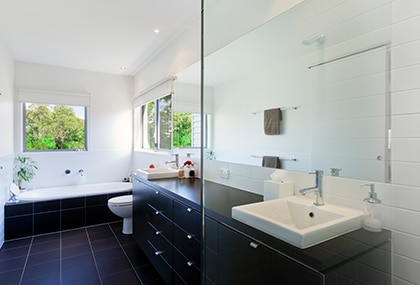
Call Us Today!

Call Us Today!
Managing humidity and moisture is essential for protecting toilets in New Orleans. Due to the city’s naturally humid environment, bathrooms are highly vulnerable to mold and mildew. These issues extend beyond aesthetics; they may lead to respiratory difficulties, unpleasant odors, and expensive structural damage.
TurnKey Renovators understands the local challenges, which is why knowing the tips for preventing mold and mildew in your New Orleans bathroom is vital for both health and home preservation. If you’re ready to take control of moisture in your space, we’re here to help. Reach out to us anytime to get started with solutions that fit your home.

Humidity control is important. Excess moisture creates a first-class environment for mold. Start using moisture-resistant materials to maintain a constant airflow. Immediately fix the leak and stop the shape before you start. Even basic steps like opening windows and diverting water can make a huge difference.
The subtropical climate of New Orleans makes the bathrooms especially moldy. High humidity, combined with frequent rain and intense heat, promotes the development of mold, especially in spaces that have been filled with steam and condensation used daily.
Bathrooms hold onto excess moisture from hot showers, and if ventilation is insufficient, that moisture is nearly impossible to escape. Condensation builds up on tiles, drywall, and mirrors, accelerating mold development. Aged houses, especially those constructed many years ago, are even more susceptible because of worn-out materials and inadequate seals.
Black mold (Stachybotrys) and green mold (Cladosporium) are frequently observed on damp walls, floors, and ceilings. Mildew, being lighter, usually shows up on shower curtains and grout. Mildew, which is lighter, typically appears on shower curtains and grout. They reproduce with airborne spores, so frequent cleaning and checking are critical.
Mold exposure is a known allergen that can exacerbate asthma and irritate skin. The longer it is left unchecked, the more serious it becomes. Mold prevention is more than cosmetic—it can lead to a healthier living environment.
Good ventilation lowers moisture levels and keeps air circulating. In a place like New Orleans, it’s one of the best defenses against mold. Several simple changes can make a major impact.
Exhaust fans remove humid air. Models with humidity sensors automatically turn on when needed, and proper venting to the outside ensures that moisture leaves the house instead of collecting in the attic.
Allowing fresh air to come in decreases humidity. When showering, open the bathroom window and keep the door slightly ajar to facilitate cross-ventilation. This is one of the simplest yet most potent tips for avoiding mildew and mold in your New Orleans bathroom.
In small, unventilated bathrooms, a portable dehumidifier can help control dampness. Aim for under 60% humidity. Just don’t forget to wash the tank frequently to avoid inside mold.
Routine service keeps your exhaust fans and ducts functioning properly. Dust off the dust and inspect it for wear so that nothing is blocking airflow.
Less clutter means fewer hiding places for moisture. Strategic placement of smart vents and fixtures aids in moisture management.

Controlling humidity is an ongoing process, especially in this climate. Routine care keeps mold and mildew at bay.
Even a small drip can lead to big mold issues. Inspect pipes, faucets, and shower seals regularly. If a leak is spotted, address it immediately.
Anti-mold sprays stop accumulation on tiles and glass surfaces. Select sustainable products and utilize them regularly for optimal outcomes.
Wipe down shower walls and doors with a squeegee. This simple task removes most of the lingering water. Also, dry sinks and counters after use.
Air conditioning helps lower overall humidity, making it harder for mold to grow. It works best when combined with dehumidifiers and clean HVAC filters.
Fewer items mean better airflow. Keep damp towels out of the bathroom and avoid using rugs that trap moisture.
In damp New Orleans, bathrooms are vulnerable to mold. Selecting the proper materials increases durability and makes upkeep easier. No- or low-VOC choices repel water and lower humidity levels.
Paints with antimicrobial agents resist mold growth. Apply a protective sealant to corners and joints to block moisture.
Among the greatest choices for floors are ceramic and vinyl tiles. Acrylic or fiberglass panels are two options for walls that guarantee easy upkeep and water resistance.
Grout must be sealed to prevent water intrusion because it is porous. For further protection, use a grout sealant to coat the grout once a year.
Stay away from heavy materials. Light, quick-drying fabrics discourage the growth of mold and are simpler to clean.
Granite and quartz resist moisture and are easy to clean. If porous materials are used, sealing them regularly will help guard against mold.
Routine cleaning matters more here than in many other places. Keeping mold and mildew away requires consistent effort.
Focus on grout lines, corners, and damp surfaces. Mold-specific cleaning products, used weekly, go a long way in prevention. Always wear gloves and keep the area ventilated when using cleaners.
Launder towels and bath mats frequently. Don’t leave damp laundry sitting in the bathroom.
Quarterly deep cleaning of walls, ceilings, and behind fixtures helps catch early signs of mold. It’s also a good time to reapply sealants and inspect plumbing.
Keeping your bathroom dry and mold-free in New Orleans doesn’t have to be complicated. With the right approach, you can create a space that stays fresh and lasts longer. Smart ventilation, routine upkeep, and the right materials all go a long way in preventing moisture buildup and mold growth. A well-maintained bathroom not only feels better—it also adds value and comfort to your home.
Want help making it happen? Contact us at TurnKey Renovators for expert advice and reliable work tailored to the New Orleans climate. Let’s build a bathroom that works better for you.

